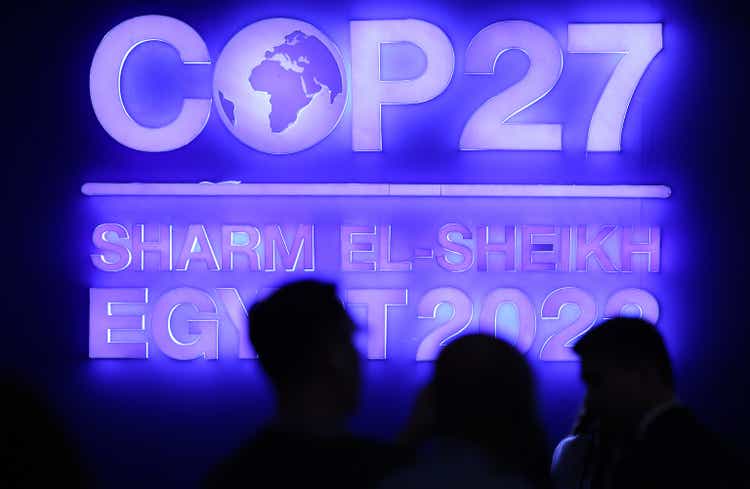Sean Gallup/Getty Images News
The shifting geopolitical landscape accelerated by the Russia-Ukraine conflict will complicate the main goals of this year’s United Nations Climate Change Conference (COP27).
COP27 will take place on Nov. 6-18. Egypt, the host country, has framed the conference as one of actual “implementation” of the Paris Agreement targets, moving away from mere pledges. This will be challenging, given the increased economic and security volatility owing to the Russia-Ukraine conflict.
Global climate adjustment is falling behind in meeting the targets of limiting temperature rise to below 2 degrees Celsius – and ideally less than 1.5 degrees Celsius above pre-industrial levels – and reaching net-zero emissions by 2050.
Only 24 countries have reviewed their plans for climate action since COP26 in 2021, and even fewer have made meaningful changes to their emissions targets. Using the current targets, the UN warned on Oct. 26 that temperatures will rise by 2.1-2.9 degrees Celsius by 2050.
The Egyptian government is focusing COP27 on securing sufficient finance for developing countries to manage energy transition without undermining development trajectories. Egypt is emphasizing the need to make such investment more attractive to the private sector and reducing affected countries’ debt burdens.
‘Loss and damage’
Developing economies vulnerable to climate change are likely to undertake concerted calls for “loss and damage” (L&D) mechanisms, as well as debt relief and debt swaps to fund adaptation and mitigation programs.
Following climate change-associated heavy flooding in Pakistan in mid-2022, the then-finance minister requested bilateral and multilateral creditors in September to swap debt with “climate change financing initiatives” to free up funds to support rebuilding and economic recovery projects. Although the new finance minister has since dismissed these calls, policy support for “debt-for-climate swaps” is likely to grow, with countries with high debt burdens also facing climate change-driven stresses.
In Latin America, some governments are likely to demand debt relief to free up resources to protect the environment, spearheaded by Colombian President Gustavo Petro, who is promoting the phasing-out of hydrocarbons in favor of renewable energy in his country. Brazil’s newly elected president, Luiz Inácio Lula da Silva, is likely to make similar demands to protect the Amazon.
Small island developing states are particularly vulnerable to the effects of climate change. In COP27, Caribbean countries are likely to act as a bloc to demand L&D funding from developed states with the highest greenhouse gas (GHG) emissions. Other low-income countries, especially tourism-dependent small islands in the Asia Pacific and sub-Saharan Africa that are vulnerable to sea-level rise, are likely to join these calls.
Fiscal constraints
The Russia-Ukraine conflict is putting economic strains on developed countries committed to climate finance and hindering the implementation of energy transition goals. The European Union’s (EU) reluctance to commit to additional climate financing will be compounded by energy supply disruption and increased domestic fiscal spending to shield the bloc’s households and industry from energy supply shocks arising out of the conflict.
Fiscal constraints increase the likelihood that countries will have to turn to multilateral lenders and private finance. The EU is likely to push for the promotion of local market-based financing to facilitate green bond issuance in low- and middle-income countries. More broadly, the EU and the US are aligned with international financial institutions such as the International Monetary Fund (IMF), to which more countries are likely to turn, including the IMF’s recently established USD50-billion Resilience and Sustainability Trust (RST).
Major economies are likely to prioritize the provision of climate funding and aid based on their own geopolitical objectives. For example, the US is likely to favor members of the Indo-Pacific Economic Framework for Prosperity, which includes provisions on clean energy and decarbonization. Favoring allies is also likely for larger Asia Pacific countries, such as Australia, mainland China, India, and Japan.
Editor’s Note: The summary bullets for this article were chosen by Seeking Alpha editors.


Be the first to comment